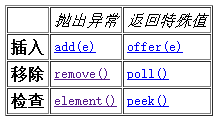Queue是什么
隊列,是一種數據結構。除了優先級隊列和LIFO隊列外,隊列都是以FIFO(先進先出)的方式對各個元素進行排序的。無論使用哪種排序方式,隊列的頭都是調用remove()或poll()移除元素的。在FIFO隊列中,所有新元素都插入隊列的末尾。隊列都是線程安全的,內部已經實現安全措施,不用我們擔心
?
Queue中的方法
Queue中的方法不難理解,6個,每2對是一個也就是總共3對。看一下JDK API就知道了:

注意一點就好,Queue通常不允許插入Null,盡管某些實現(比如LinkedList)是允許的,但是也不建議。
ArrayBlockingQueue:基于數組實現的一個阻塞隊列,在創建ArrayBlockingQueue對象時必須制定容量大小。并且可以指定公平性與非公平性,默認情況下為非公平的,即不保證等待時間最長的隊列最優先能夠訪問隊列。
LinkedBlockingQueue:基于鏈表實現的一個阻塞隊列,在創建LinkedBlockingQueue對象時如果不指定容量大小,則默認大小為Integer.MAX_VALUE。
PriorityBlockingQueue:以上2種隊列都是先進先出隊列,而PriorityBlockingQueue卻不是,它會按照元素的優先級對元素進行排序,按照優先級順序出隊,每次出隊的元素都是優先級最高的元素。注意,此阻塞隊列為無界阻塞隊列,即容量沒有上限(通過源碼就可以知道,它沒有容器滿的信號標志),前面2種都是有界隊列。
DelayQueue:基于PriorityQueue,一種延時阻塞隊列,DelayQueue中的元素只有當其指定的延遲時間到了,才能夠從隊列中獲取到該元素。DelayQueue也是一個無界隊列,因此往隊列中插入數據的操作(生產者)永遠不會被阻塞,而只有獲取數據的操作(消費者)才會被阻塞。
注意:
1、必須要使用take()方法在獲取的時候達成阻塞結果
2、使用poll()方法將產生非阻塞效果
public class ArrayBlockingQueue<E> extends AbstractQueue<E>implements BlockingQueue<E>, java.io.Serializable {private static final long serialVersionUID = -817911632652898426L;/** The queued items */private final E[] items;/** items index for next take, poll or remove */private int takeIndex;/** items index for next put, offer, or add. */private int putIndex;/** Number of items in the queue */private int count;/** Concurrency control uses the classic two-condition algorithm* found in any textbook.*//** Main lock guarding all access */private final ReentrantLock lock;/** Condition for waiting takes */private final Condition notEmpty;/** Condition for waiting puts */private final Condition notFull;}
public ArrayBlockingQueue(int capacity) {}public ArrayBlockingQueue(int capacity, boolean fair) {?}public ArrayBlockingQueue(int capacity, boolean fair,????????????????????????? Collection<? extends E> c) {}
public void put(E e) throws InterruptedException {??? if (e == null) throw new NullPointerException();??? final E[] items = this.items;??? final ReentrantLock lock = this.lock;??? lock.lockInterruptibly();??? try {??????? try {??????????? while (count == items.length)??????????????? notFull.await();??????? } catch (InterruptedException ie) {??????????? notFull.signal(); // propagate to non-interrupted thread??????????? throw ie;??????? }??????? insert(e);??? } finally {??????? lock.unlock();??? }}
private void insert(E x) {??? items[putIndex] = x;??? putIndex = inc(putIndex);??? ++count;??? notEmpty.signal();}
public E take() throws InterruptedException {??? final ReentrantLock lock = this.lock;??? lock.lockInterruptibly();??? try {??????? try {??????????? while (count == 0)??????????????? notEmpty.await();??????? } catch (InterruptedException ie) {??????????? notEmpty.signal(); // propagate to non-interrupted thread??????????? throw ie;??????? }??????? E x = extract();??????? return x;??? } finally {??????? lock.unlock();??? }}
private E extract() {??? final E[] items = this.items;??? E x = items[takeIndex];??? items[takeIndex] = null;??? takeIndex = inc(takeIndex);??? --count;??? notFull.signal();??? return x;}
public class Test {??? private int queueSize = 10;??? private PriorityQueue<Integer> queue = new PriorityQueue<Integer>(queueSize);???? public static void main(String[] args)? {??????? Test test = new Test();??????? Producer producer = test.new Producer();??????? Consumer consumer = test.new Consumer();???????? producer.start();??????? consumer.start();??? }???? class Consumer extends Thread{???????? @Override??????? public void run() {??????????? consume();??????? }???????? private void consume() {??????????? while(true){??????????????? synchronized (queue) {??????????????????? while(queue.size() == 0){??????????????????????? try {??????????????????????????? System.out.println("隊列空,等待數據");??????????????????????????? queue.wait();??????????????????????? } catch (InterruptedException e) {??????????????????????????? e.printStackTrace();??????????????????????????? queue.notify();??????????????????????? }??????????????????? }??????????????????? queue.poll();????????? //每次移走隊首元素??????????????????? queue.notify();??????????????????? System.out.println("從隊列取走一個元素,隊列剩余"+queue.size()+"個元素");??????????????? }??????????? }??????? }??? }???? class Producer extends Thread{???????? @Override??????? public void run() {??????????? produce();??????? }???????? private void produce() {??????????? while(true){??????????????? synchronized (queue) {??????????????????? while(queue.size() == queueSize){??????????????????????? try {??????????????????????????? System.out.println("隊列滿,等待有空余空間");??????????????????????????? queue.wait();??????????????????????? } catch (InterruptedException e) {??????????????????????????? e.printStackTrace();??????????????????????????? queue.notify();??????????????????????? }??????????????????? }??????????????????? queue.offer(1);??????? //每次插入一個元素??????????????????? queue.notify();??????????????????? System.out.println("向隊列取中插入一個元素,隊列剩余空間:"+(queueSize-queue.size()));??????????????? }??????????? }??????? }??? }}
public class Test {private int queueSize = 10;private ArrayBlockingQueue<Integer> queue = new ArrayBlockingQueue<Integer>(queueSize);public static void main(String[] args) {Test test = new Test();Producer producer = test.new Producer();Consumer consumer = test.new Consumer();producer.start();consumer.start();}class Consumer extends Thread{@Overridepublic void run() {consume();}private void consume() {while(true){try {queue.take();System.out.println("從隊列取走一個元素,隊列剩余"+queue.size()+"個元素");} catch (InterruptedException e) {e.printStackTrace();}}}}class Producer extends Thread{@Overridepublic void run() {produce();}private void produce() {while(true){try {queue.put(1);System.out.println("向隊列取中插入一個元素,隊列剩余空間:"+(queueSize-queue.size()));} catch (InterruptedException e) {e.printStackTrace();}}}}}




)





)




)



